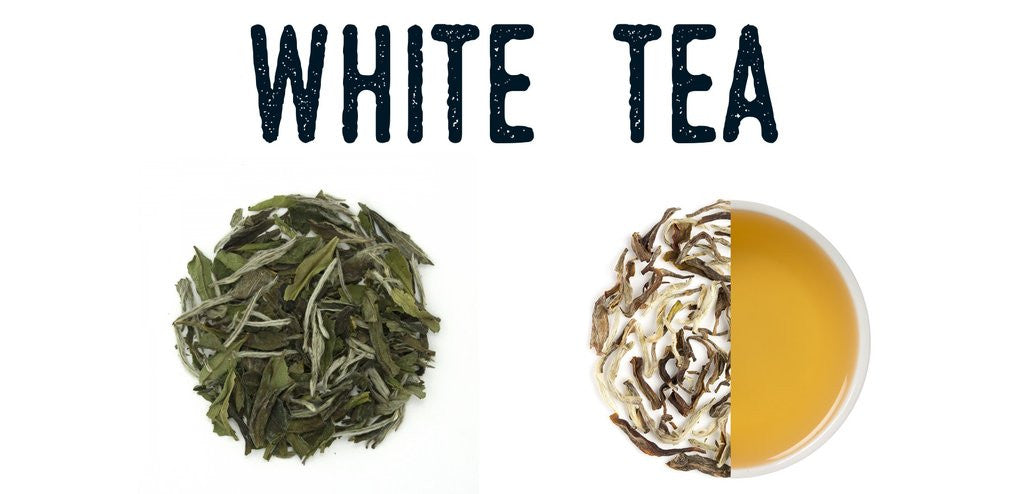There are 5 major tea types in the U.S.:
- White
- Green
- Oolong
- Black
- Dark
Please note: Other types of tea do exist (like Yellow Tea), but I will not mention them here because A) they are very rare and make up a small percentage of total tea production and B) I don’t sell them!
White Tea is made from tea leaves that are laid out to wither and dry. Nothing is done to promote or inhibit oxidation. The leaves are neither shaped nor fired, making it the most minimally processed tea type there is.

Freshly picked tea leaves withering indoors.
Plucking
White tea is harvested from the newest growth on the tea plant. The most delicate, sophisticated, and expensive white teas consist entirely of leaf buds. Other white teas blend leaf buds with leaf shoots and unfurled leaves to develop a fuller body and more robust flavor profile (they’re also more affordable).


The white tea on the left (Silver Needles) is made entirely of buds while the white tea on the right (White Peony) incorporates leaves and leaf shoots.
Withering
After the leaves have been plucked, they are laid out to wither. Ideally, the withering process would take place outside during warm, dry weather. On days with less-than-ideal weather, the leaves would wither inside a climate-controlled room.
Drying
In white tea production, drying is simply “extended withering” until the moisture content in the leaves is reduced and is ready for packaging. Ideally this is done outside, but the operation can be moved indoors if the weather is not cooperating.
Country of Origin
White tea is harvested primarily in China. Some white teas by definition must come from a cultivar of the original white tea trees located in the Fujian province of China. We are fortunate enough to live in a world where other countries have developed their own delicious white teas.
Appearance, Aroma, and Flavor
White tea can easily be distinguished by looking at the dry leaves. The young buds, shoots, and leaves are still covered with fine white hairs, hence the name “white tea.” The leaves (if there are any) are full, light, and intact.
The liquor of white tea is pale yellow with an intoxicating aroma that is both floral and reminiscent of fresh-cut hay. The taste is sweet, floral, and vegetal. The body is tea in its purest form: smooth, fluid, and delicate.
Types of White Tea
At Leaf & Bean NOLA, we currently sell two different White Teas
Bai Mu Dan (White peony)
If you are looking to try White Tea for the first time, this is the place to start. This is a no-frills white tea that’s affordable and simply tastes like white tea should. No wonder it’s reppin’ the White Tea category in the Tea Collector Starter Kit.
Bai Mu Dan originates from the Fujian province in China. Unlike its far more sophisticated (and expensive) brother Bai Hao Yin Zhen (Silver Needles) that is made entirely of buds, Bai Mu Dan includes some buds blended with shoots and young leaves. This blend of buds and leaves creates a tea that is more robust in body and flavor. If you have not tried it yet, do yourself a favor and pick some up today.
Darjeeling White
Darjeeling White is a sweet, full-bodied white tea with an atypical origin. You won’t see it in many cafes, which makes it a special treat for any white tea lover.
As I mentioned previously, White Tea traditionally comes from the Fujian province in China. What makes this tea so special is that it hails from Darjeeling India, a town that’s world renowned for its black teas. Compared to Bai Mu Dan, Darjeeling White has a darker colored liquor with a fuller body and a flavor profile with subtle notes of sweet honey.
Brewing Techniques
White teas are delicate in nature, and they should be brewed accordingly.
As always, use 2.5-3 grams of dry tea leaves for every 6-8oz of water. White tea leaves are typically larger and lighter than most tea types, so if you’re measuring your tea leaves in teaspoons be sure to compensate by adding an extra scoop of leaves.
Water temperature should be around 160°F. More robust white teas with lots of leaf shoots and unfurled leaves can be brewed at higher temperatures, but there is no need to ever exceed 175°F.
Steep time should be around 1min. Steep time can be longer if your tea has a lot of leaf shoots and unfurled leaves and you like a more robust flavor profile. Add another 30 seconds of brew time to every subsequent infusion. You can expect your tea leaves to be good for around 3 infusions.
Perceived Benefits
The different health benefits and caffeine levels within each tea type are controversial and unproven. Many tea retailers will tell you that white tea has the least amount of caffeine and an abundance of health benefits. Me personally, the strongest caffeine buzz I’ve ever gotten from tea came from drinking multiple infusions of white tea. The point is, we just don’t know how healthy and caffeinated white tea is compared to other types, but man does it feel good to drink!
White tea is amazing. The beauty is in its delicate body and sophisticated flavor profile. Anyone interested in developing their palette for tea should start here and slowly work their way through the tea types, increasing the oxidation level of the tea as they go. The next stop on our tea journey is green tea. I can’t wait!
Drink up!
Charles


